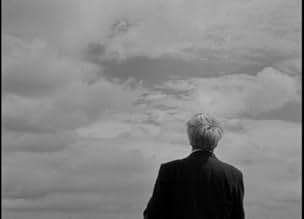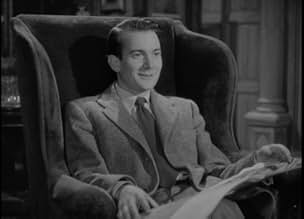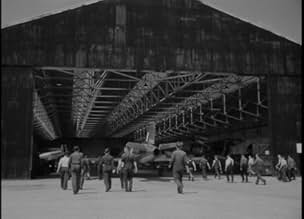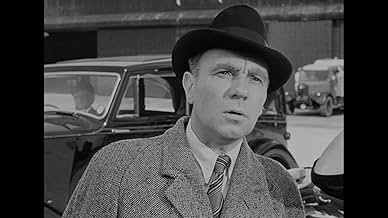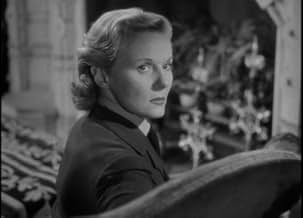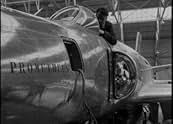NOTE IMDb
6,7/10
2,5 k
MA NOTE
Ajouter une intrigue dans votre langueFictionalized story of British aerospace engineers solving the problem of supersonic flight.Fictionalized story of British aerospace engineers solving the problem of supersonic flight.Fictionalized story of British aerospace engineers solving the problem of supersonic flight.
- Récompensé par 1 Oscar
- 9 victoires et 5 nominations au total
Rodney Goodall
- Little Boy
- (non crédité)
Donald Harron
- ATA Officer
- (non crédité)
Vincent Holman
- Factor
- (non crédité)
Jolyon Jackley
- Susan's Baby
- (non crédité)
Douglas Muir
- Controller
- (non crédité)
Leslie Phillips
- Controller
- (non crédité)
Anthony Snell
- Peter Makepeace
- (non crédité)
Sally-Jane Spencer
- Daughter of Philip
- (non crédité)
Robert Brooks Turner
- Test Bed Operator
- (non crédité)
Avis à la une
This is an outstanding film about the human cost of progress and obsession. Richardson is great as the aviation mogul willing to pay the necessary price for reaching new realms and new worlds. Historically and technically, the film is so out in left field as to be almost laughable (the plot point about control reversal is apparently the result of a writer hearing a valid aeronautical term and misunderstanding it completely) but in the end, the issues raised and the fine performances make Sound Barrier a winner. The aerial photography is outstanding, and there is one beautifully composed shot from below the nose of the Comet airliner that perfectly emphasizes the sleek lines of that most beautiful jet.
This black and white early 50s movie shows crusty Britain at its stiff upper lip best. It is the story of mans obsession with speed, and a ruthless plane makers ambition to succeed in building a supersonic jet. Richardson plays the tycoon whose dream kills his son and son-in-law, but who finally sees the error of his ways and whose daughter returns to the cold family home with his grandson.
The film is also a vehicle to show the world Britain's proud lead in jet technology. There is a classic sequence in the film where the happy daughter and son-in-law deliver a De Havilland Vampire jet fighter to Egypt. They set off at breakfast time in England and hurtle over the English Channel, the Alps, Ancient Greece and the Pyramids before arriving in at the airfield. Of course we take this for granted now, but 47 years ago this was unheard of. The director contrasts the old ruins and remains of our ancient ancestors with the marvel of the modern age: the jet plane.
The film also introduced THE marvel of the early fifties, the De Havilland Comet jet liner. This beautiful but flawed machine was in service SIX years before any other jet liner and for a while, the world rushed to De Havillands, and Britains door. For two years the worldwide fleet gave the travelling of the future.
In every other way this is an eccentrically English film with creaky old houses, cottages with roses around the door and eccentric engineers. Shout in glorious black and white it conveys a sense of wonder and optimism in the future, whilst being thoroughly old fashioned
The film is also a vehicle to show the world Britain's proud lead in jet technology. There is a classic sequence in the film where the happy daughter and son-in-law deliver a De Havilland Vampire jet fighter to Egypt. They set off at breakfast time in England and hurtle over the English Channel, the Alps, Ancient Greece and the Pyramids before arriving in at the airfield. Of course we take this for granted now, but 47 years ago this was unheard of. The director contrasts the old ruins and remains of our ancient ancestors with the marvel of the modern age: the jet plane.
The film also introduced THE marvel of the early fifties, the De Havilland Comet jet liner. This beautiful but flawed machine was in service SIX years before any other jet liner and for a while, the world rushed to De Havillands, and Britains door. For two years the worldwide fleet gave the travelling of the future.
In every other way this is an eccentrically English film with creaky old houses, cottages with roses around the door and eccentric engineers. Shout in glorious black and white it conveys a sense of wonder and optimism in the future, whilst being thoroughly old fashioned
The opening of the film, when a World War II fighter pilot hit what used to be called "compressibility," was a suspenseful interlude for the audience, particularly since it wasn't explained at the time.
The film was shot in monochrome, and was produced during a time that technology was accelerating, and this was one of the early films outside some of the science-fiction films of the era that was pro-technology. It is interesting that most of the major characters were obsessed with pushing the envelope.
As has been mentioned elsewhere, the "solution" presented to maintaining control of a supersonic aircraft actually is inaccurate. When a reporter asked the person who first actually broke the sound barrier, Gen. Chuck Yaeger, about that "solution," he indicated that doing what was proposed would have ensured the death of the pilot.
The film is well worth watching, if for no other reason than to get a taste of people taking baby steps in the new world of postwar technology.
The film was shot in monochrome, and was produced during a time that technology was accelerating, and this was one of the early films outside some of the science-fiction films of the era that was pro-technology. It is interesting that most of the major characters were obsessed with pushing the envelope.
As has been mentioned elsewhere, the "solution" presented to maintaining control of a supersonic aircraft actually is inaccurate. When a reporter asked the person who first actually broke the sound barrier, Gen. Chuck Yaeger, about that "solution," he indicated that doing what was proposed would have ensured the death of the pilot.
The film is well worth watching, if for no other reason than to get a taste of people taking baby steps in the new world of postwar technology.
A young RAF pilot test's his father-in-law's prototype supersonic aircraft to the limit, at a time of intense development activity in the field of aviation, just as commercial jet airliners are about to come into service.
This is one of David Lean's less well-known films, in which some of the development milestones and incidents in contemporary UK aviation were put into a dramatic context. It should be mentioned that the aero industry was probably the UK's largest single industry by the end of WWII; it is thought that approximately 25% of the entire UK economy was devoted to aircraft manufacturing and allied industries; for four long years air power had been Britain's main means of striking back at Germany. Although activities were somewhat reduced in peacetime, the UK lead the way in several key aviation fields in the late 1940s and early 1950s; there was a new Cold War to be fought.
Now, lot of reviews here assume that the events portrayed were completely fictional (a la U571); whilst no film is beyond reproach in this respect in point of fact in this case nothing could be further from the truth; this film used no fewer than eight of the UK's most experienced test pilots as consultants. One of the eight, John Derry, reached supersonic speeds on 9th september 1948, whilst in a shallow dive in the third DH108 prototype.
The phenomenon of 'control reversal' at transonic speeds can and does occur with some wing designs; essentially at very high speeds the angle of attack of the wing is dramatically altered (because the control surface loads twist the wing essentially) and thus the intended effect of the controls can be reversed. This phenomenon is known to have afflicted aircraft such as early marks of spitfire, and this could limit the safe speed in a dive until a (torsionally stiffer) revised wing was introduced. It is just one of the many things that can occur in or near the transonic regime, and was probably chosen for the film because it is both simple and dramatic, and by then fairly well-known.
Flying military jet aircraft at that time was incredibly dangerous even without being shot at; peacetime training accidents were numerous. On some types an aircraft would be lost for every 1000 hours flying time and in a little under half of those losses the pilot was killed too. Test pilots had it worse than that; one of the eight test pilots who was consultant on this film was credited posthumously; he passed away between when the film was shot and released. Indeed the film refers to the loss of Geoffrey de Havilland (which in reality occured in 1946) again in a DH108 prototype. It is sobering to note that there are no surviving DH108 prototypes because they were all lost in (fatal) crashes.
In this film the human drama is played well enough with fine ating and good production values, but all this definitely takes second place to the aircraft and the flying. We see (apparently) a wartime spitfire in a high speed dive, Supermarine Attacker WA485, De Havilland Comet G-ALYR, a De Havilland Vampire and a Supermarine Swift.
In one magical sequence they have breakfast in the UK, fly to Cairo for lunch whilst delivering an aircraft, and then cadge a ride home on a Comet undergoing evaluation testing for BOAC. All at high altitude, high speed, jet-smooth, way above the clouds; something airline passengers of the time could only imagine until the Comet entered service during 1952.
Comet G-ALYR (one of the first batch of production Comet Mk 1 aircraft) was badly damaged in a taxi-ing accident a year or so after this film was made. Nonetheless it had already flown about 750 times and the fuselage was eventually used for water-tank fatigue testing, the lessons of which were learned from world-wide and are still relevant to this day.
This film isn't technically perfect but it is by no means as flawed as others would have you believe. It is stronger as a film about flying than a drama, but it is by no means bad in either respect. It gets a solid 8/10 from me.
This is one of David Lean's less well-known films, in which some of the development milestones and incidents in contemporary UK aviation were put into a dramatic context. It should be mentioned that the aero industry was probably the UK's largest single industry by the end of WWII; it is thought that approximately 25% of the entire UK economy was devoted to aircraft manufacturing and allied industries; for four long years air power had been Britain's main means of striking back at Germany. Although activities were somewhat reduced in peacetime, the UK lead the way in several key aviation fields in the late 1940s and early 1950s; there was a new Cold War to be fought.
Now, lot of reviews here assume that the events portrayed were completely fictional (a la U571); whilst no film is beyond reproach in this respect in point of fact in this case nothing could be further from the truth; this film used no fewer than eight of the UK's most experienced test pilots as consultants. One of the eight, John Derry, reached supersonic speeds on 9th september 1948, whilst in a shallow dive in the third DH108 prototype.
The phenomenon of 'control reversal' at transonic speeds can and does occur with some wing designs; essentially at very high speeds the angle of attack of the wing is dramatically altered (because the control surface loads twist the wing essentially) and thus the intended effect of the controls can be reversed. This phenomenon is known to have afflicted aircraft such as early marks of spitfire, and this could limit the safe speed in a dive until a (torsionally stiffer) revised wing was introduced. It is just one of the many things that can occur in or near the transonic regime, and was probably chosen for the film because it is both simple and dramatic, and by then fairly well-known.
Flying military jet aircraft at that time was incredibly dangerous even without being shot at; peacetime training accidents were numerous. On some types an aircraft would be lost for every 1000 hours flying time and in a little under half of those losses the pilot was killed too. Test pilots had it worse than that; one of the eight test pilots who was consultant on this film was credited posthumously; he passed away between when the film was shot and released. Indeed the film refers to the loss of Geoffrey de Havilland (which in reality occured in 1946) again in a DH108 prototype. It is sobering to note that there are no surviving DH108 prototypes because they were all lost in (fatal) crashes.
In this film the human drama is played well enough with fine ating and good production values, but all this definitely takes second place to the aircraft and the flying. We see (apparently) a wartime spitfire in a high speed dive, Supermarine Attacker WA485, De Havilland Comet G-ALYR, a De Havilland Vampire and a Supermarine Swift.
In one magical sequence they have breakfast in the UK, fly to Cairo for lunch whilst delivering an aircraft, and then cadge a ride home on a Comet undergoing evaluation testing for BOAC. All at high altitude, high speed, jet-smooth, way above the clouds; something airline passengers of the time could only imagine until the Comet entered service during 1952.
Comet G-ALYR (one of the first batch of production Comet Mk 1 aircraft) was badly damaged in a taxi-ing accident a year or so after this film was made. Nonetheless it had already flown about 750 times and the fuselage was eventually used for water-tank fatigue testing, the lessons of which were learned from world-wide and are still relevant to this day.
This film isn't technically perfect but it is by no means as flawed as others would have you believe. It is stronger as a film about flying than a drama, but it is by no means bad in either respect. It gets a solid 8/10 from me.
7sol-
British aviation enthusiasts seek to break the sound barrier by dangerously pushing their jets beyond their limits in this solidly crafted drama starring Ralph Richardson. The film has copped a lot of flak over the years for its historical inaccuracies (the Americans were actually the first to break the sound barrier with very different techniques), however, 'The Sound Barrier' works well as a character drama as long as one takes all the pseudoscience on hand with a pinch of salt. The movie is rather slow to warm up, focusing on a formulaic courtship between Richardson's daughter and an up and coming pilot, however, as soon as Richardson enters the scene, it becomes an experience that rarely lets up. It is quite a sight to see Richardson's boyish enthusiasm for the task at hand, waxing poetic about a "whole new world ... in the grasp of man", demonstrating how aerial flight works during dinner and proclaiming that "it's just got to be done". His character also comes with shades of ambiguity; is he at all guilt-ridden over the deaths of those trying to complete the quest or does he see the deaths as acceptable in the name of human progress? Richardson does very well adding such shades to his character and while none of the supporting players come close to equaling him, he is enough alone to carry the film, or at least when on-screen. The film is also blessed by some great spinning shots within mysterious clouds and as one might expect from a film with such a title, the Oscar winning sound mixing here is highly effective.
Le saviez-vous
- AnecdotesThe flying sequences under the direction of Anthony Squire, were based at the Vickers aerodrome at Chilbolton near Nether Wallop in Hampshire. Squire managed to secure one of the last airworthy Avro Lancaster bombers for the task. The cameramen were positioned in the front and rear turrets while Squire conducted proceedings from the central astrodome. The Lancaster was replaced by a Vickers Valetta after all the crew except Squire fell asleep due to an oxygen supply failure. Luckily as he recalled, "They all woke up on the way down, like people in a fairy wood, but I didn't bother with the Lancaster again."
- GaffesAfter he and his wife alight from a Comet airliner, Garthwaite is seen reading that evening's newspaper, dated Saturday, 28 September 1946. The Comet didn't make its maiden flight until July 1949 and didn't enter service until 1952.
- Citations
Susan Garthwaite: [regarding an image of the surface of the moon, displayed via JR's telescope] What's that?
John Ridgefield: It's the moon.
Susan Garthwaite: I never knew it could look so unfriendly.
John Ridgefield: It's an unfriendly universe.
Susan Garthwaite: Do you believe that?
John Ridgefield: Unfriendly only because it's unconscious of our existence.
- Crédits fousIn the opening credits, immediately after the human actors, are listed four British aircraft: The de Havilland COMET The Vickers-Supermarine ATTACKER The de Havilland VAMPIRE 113 The Vickers-Supermarine SWIFT Rolls-Royce 'Avon' Engine
- ConnexionsFeatured in Jet! When Britain Ruled the Skies: Military Marvels (2012)
- Bandes originalesWith Sword and Lance
(uncredited)
Music by Hermann Starke
Meilleurs choix
Connectez-vous pour évaluer et suivre la liste de favoris afin de recevoir des recommandations personnalisées
- How long is The Sound Barrier?Alimenté par Alexa
Détails
- Date de sortie
- Pays d’origine
- Langue
- Aussi connu sous le nom de
- Breaking the Sound Barrier
- Lieux de tournage
- Chilbolton Aerodrome, Nether Wallop, Hampshire, Angleterre, Royaume-Uni(flying sequences)
- Sociétés de production
- Voir plus de crédits d'entreprise sur IMDbPro
Box-office
- Budget
- 250 000 £GB (estimé)
- Durée
- 1h 58min(118 min)
- Couleur
- Rapport de forme
- 1.37 : 1
Contribuer à cette page
Suggérer une modification ou ajouter du contenu manquant


